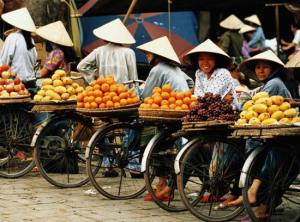
Generally speaking we can say that the Vietnamese economy continues its steady growth – for the first nine months of 2014, GDP growth was 5.62%, higher than the inflation rate of 5%. The key index PMI, which indicates the situation in production over the course of 13 months, is higher than 50 points. Exports are also showing a positive trend. Over the nine month period export volume climbed to US $109.63 billion, 14.2% higher than the same period in 2013. The trade surplus is US $2.47 billion.
Vietnam’s stock market continues to rank among the top five fastest growing markets in the world. During the first nine months of 2014 the key indices (VN-Index and HNX-Index) rose by 19.9% and 30.4% respectively compared with the same period in 2013. The Vietnamese real estate market is growing as well, the rate of the Vietnamese Dong remains stable, and the country’s currency reserves reached a record level of US $35 billion.
The situation in the economy today is so favourable for investment that the US Chamber of Commerce in Singapore include Vietnam in the list of the most attractive ASEAN countries for American businessmen. The well-known Fitch rating agency recently announced its intention to increase Vietnam’s rating from B + to BB- due to the stable growth of the economy.
It should be noted that, like any growing Asian economy, Vietnam faces a number of relevant problems. Vietnamese economists consider it dangerous that the national economy is highly dependent on foreign-owned enterprises, which account for about 70% of the country’s total exports. Another problem is the low demand in the domestic market, it is 1.5% lower today than a year ago. The number of liquidated companies is also large. In less than nine months in 2014 about 50,000 companies went bankrupt, slightly more than in 2013. The amount of arrears of economic actors is also great, and the process of privatising public sector enterprises is proceeding slowly. During the first eight months of 2014 only 55 out of 432 companies were privatized, all of which must undergo this procedure by 2015.
It should be noted that all these problems, although they create difficulties in the development of the economy, do not in fact have a critical effect on the overall acceleration of development. The key indicators of the Vietnamese economy look very positive, so virtually all the international rating agencies have made forecasts of GDP growth in Vietnam of 5.4-5.6% in 2014 and 6% and 6-7% in 2015 and 2016-2017, respectively.
Vietnam is not the only country in Southeast Asia that is showing such positive results today. Thailand, Malaysia, Singapore, and Indonesia are also demonstrating fairly rapid economic growth in 2014. All are large and emerging markets with modern financial and industrial infrastructure. Partnership with them will not only reduce the negative impact of sanctions on the Russian economy, but also give it new impetus for development.
Dmitry Mosyakov, Professor, Ph.D. in History, head of the Centre for South-East Asia, Australia and Oceania Studies at the Institute of Oriental Studies in the Russian Academy of Sciences, exclusively for the online magazine “New Eastern Outlook”.
